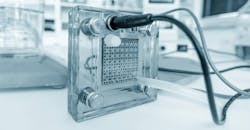Thinner Catalysts Lower Costs of Automotive Fuel Cells
Researchers at Johns Hopkins University have developed a new method of increasing the reactivity of ultrathin nanosheets, just a few atoms thick, that could make fuel cells for hydrogen cars less expensive. The same technology could also lower the price of of bulk chemicals and materials.
“Every material experiences surface strain due to the breakdown of the material’s crystal symmetry at the atomic level,” says Chao Wang, an assistant professor of chemical and biomolecular engineering at Johns Hopkins University. “We discovered a way to make these crystals ultrathin, thereby decreasing the distance between atoms and increasing the material's reactivity.”
Strain is, in short, the deformation of any material. For example, when a piece of paper is bent, the intricate lattices that hold the paper together are changed in response to the applied force.
In this project, researchers manipulated the strain effect, or distance between atoms, making the material change dramatically. By getting those lattices thin—roughly one-millionth the thickness of a human hair—the material becomes easier to manipulate, just as a single sheet of paper is easier to bend than a thicker stack of paper.
“We’re essentially using force to tune the properties of thin metal sheets that make up electrocatalysts, which are part of fuel-cell electrodes,” says Jeffrey Greeley, professor of chemical engineering at Purdue. “The ultimate goal is to test this method on a variety of metals.”
“Tuning the materials’ thinness lets us create more strain, which changes the material’s properties, including how molecules are held together,” adds Wang. “This means we have more freedom to accelerate reactions we want on the material’s surface.”
Improving reactions can increase catalysts’ activity for fuel-cell cars. Although fuel cells represent a promising technology for emission-free electrical vehicles, the challenge lies in reducing the costs associated with the precious-metal catalysts such as platinum and palladium. This limits fuel cell viability for most consumers. A more active catalyst for fuel cells would reduce cost and clear the way for widespread adoption of green, renewable energy.
Wang and colleagues estimate that their new method can increase catalyst activity by 10 to 20 times, using 90% less precious metals than what is currently needed in a fuel cell.

